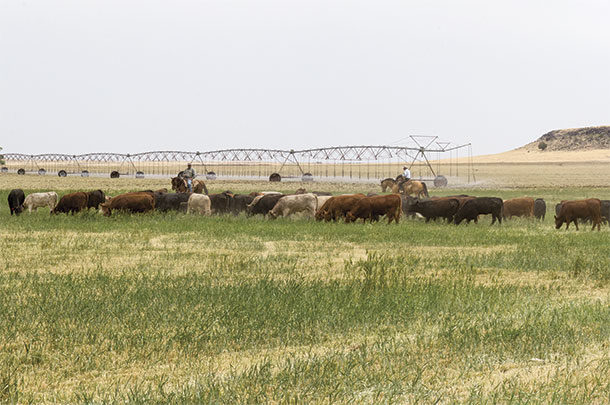This time period is characterized by slowed production and dormancy of warm-season perennial pastures, while cool-season forages may not be ready to be grazed yet.
There is a significant opportunity to extend the grazing season during this time of year by stockpiling perennial forages or incorporating cool-season annual forages into the system. If the latter route is chosen, a popular choice among producers in this region is annual ryegrass.
While planting with annual ryegrass can add grazing days during the winter months, the growth distribution of this species often does not produce the majority of its forage dry matter until spring.
Multi-species mixtures of annual ryegrass and other forage species with early season growth distribution may help decrease the number of hay and supplemental feedings days for producers on the “front end” of the season.
While there are many possible combinations of cool-season annual mixtures, small grains are species with early growth distribution and high nutritive value for grazing beef cattle in the winter months. Based on research in the Southeast, these mixtures can provide complementary production to annual ryegrass to extend the grazing season.
The following are some considerations for putting a plan into action in terms of establishment and management of small grain/ryegrass mixtures.
What species should I use in my mixture?
Cereal rye, wheat, triticale and oats are the primary species to consider for the Southeastern region. Less work has been done with barley successfully in these systems. Cereal rye is known for having the earliest availability in the season and cold tolerance relative to the other small-grain species. It tends to be less palatable and has the tendency to become stemmy quickly as it approaches maturity.
Wheat has moderate cold and disease tolerance, and it is often used in integrated crop-livestock systems in the U.S. as a dual-purpose grazing and grain crop. Triticale is a cross-species between wheat and rye, and has increased in popularity in recent years. It has relatively good cold tolerance and palatability compared to oats and wheat.
Oat is less cold-tolerant than the other small-grain species but has high quality and palatability to grazing livestock. Often, cattle will select oats in a grass mixture before other species. These small-grain species should be planted in combination with a mid- to late-maturing annual ryegrass variety to capitalize on their individual growth distribution and maximize the length of the grazing season.
Realistically, how early in the season can I graze these mixtures?
A realistic goal for “filling the gap” with cool-season annuals is to have available grazing on or before Jan. 1. As we move farther south into the Coastal Plain region, there is increasing potential for late-season fall growth (late October/November) depending upon seeding date and planting method. In general, the planting window in the southern U.S. is from mid-September through mid-October.
What factors influence my ability to get early season production?
Planting date and method of establishment largely influences early season forage production. The earlier in the planting window these cool-season forages are established, the better chance for earlier grazing. However, the planting method can influence seasonal production potential.
Many producers will consider over-seeding warm-season perennial grass pasture or establishing cool-season annuals into a prepared seedbed. Over-seeding is the more popular option and reduces the cost of establishment compared with the land preparation needed for a prepared seedbed.
Forage production in this system may be up to 50 percent less for small grain/ryegrass mixtures compared to those established into a prepared seedbed. However, even with decreased relative yield production, this system can support superior animal performance compared to cattle fed hay and supplement during this time period.
Additionally, there is less erosion in this system, which helps maintain and preserve soil quality for the forage system.
Planting into a prepared seedbed is more costly but has potential for high forage production and may especially be a fit in integrated crop-livestock operations. Cool-season annuals planted into a prepared seedbed often have a one- to two-month advantage in available forage for grazing compared to over-seeded systems, depending on climate.
Broadcasting seed or planting with a no-trill drill are the most common planting methods for establishing cool-season annuals. A no-till drill is the best method to ensure good seed-to-soil contact and uniform emergence. Acceptable plant stands can be obtained through broadcast seeding, but this method is often more variable from year to year in terms of production potential.
What kind of animal performance can I expect with different mixtures of small grains and annual ryegrass?
Stocker cattle research with cool-season annual grasses grown in monoculture or mixtures has been ongoing at the Wiregrass Research and Extension Center in Headland, Alabama, for eight consecutive years.
These research projects were conducted to quantify forage production, nutritive value and animal performance from cool-season forage varieties adapted to the Coastal Plain region of the U.S. In these studies, we evaluated the effect of moving from planting a single small-grain species to mixtures of two and three species planted together for providing grazing in the winter months.
All of this work was conducted in prepared seedbed systems. Forage was available for grazing between November and January during each year of the study.
On average, mixtures of one small grain and annual ryegrass provided between 90 to 140 days of grazing per year. When compared to small grains planted alone, the addition of annual ryegrass to the mixture provided an additional 25 to 35 days of grazing per year in these systems.
The addition of ryegrass to small grains consistently supported a stocking rate of 1.6 animals per acre within the grazing season.
Late-spring calf gain per acre and final animal bodyweight was increased in systems containing annual ryegrass compared to small grains planted alone. A study comparing “mixtures of three” was conducted to see whether the addition of multiple small-grain species provided any advantage in terms of grazing days per year.
Specifically, mixtures of wheat + rye + ryegrass, wheat + triticale + ryegrass and rye + oats + ryegrass were compared. There were no differences in these mixtures in terms of extending the grazing season relative to mixtures of a single small grain and annual ryegrass planted together.
Take-home points for your farm
Planting cool-season annuals can reduce the need for hay and supplementation during the winter months for grazing beef cattle. Small grains such as rye, oats, triticale and wheat have good forage production characteristics and can support high levels of animal performance for stocker cattle.
When a single small-grain species is planted in combination with annual ryegrass, this combination can provide winter grazing from 90 to 140 days in length, depending on the planting method used and environmental conditions. ![]()
PHOTO: Cattle grazing on small grains. Photo by Mike Dixon.

-
Kim Mullenix
- Extension Beef Specialist
- Auburn University
- Email Kim Mullenix











